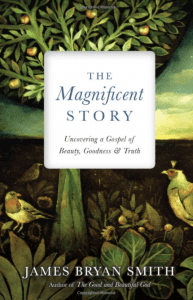 For those of us who grew up in an Augustinian narrative of who we are, our identity is bad, sinful, corrupt, evil and rebellious. James Bryan Smith, in his new book The Magnificent Story, does not deny original sin but instead contends there’s a narrative at work that is bigger that we need to embrace.
For those of us who grew up in an Augustinian narrative of who we are, our identity is bad, sinful, corrupt, evil and rebellious. James Bryan Smith, in his new book The Magnificent Story, does not deny original sin but instead contends there’s a narrative at work that is bigger that we need to embrace.
He begins the chp with a story about Rich Mullins, the Christian musician, and how Rich confessed to Jim his own story of sinfulness, both before his conversion and after his conversion. Smith’s own little narrative was challenged. That narrative — God works only through the righteous — was challenged by another narrative.
The point of this chapter is this: sin is not our essence; it is a willful act of separation that mars our likeness to God. …Surrender is not natural to us. Sin seems like a way to meet our needs. So we fight God for something we ultimately do not want, rather than take what God wants to give, which is actually what we need. We struggle because we are made in God’s image. We long for good, to be good, and to do good. When we find we are not and have not, all is not lost. We can discover what causes us to sin and why, as Rich found. And we find our freedom not in hiding our brokenness but in disclosing it.
What narrative runs through our head is what matters immensely to our health — in all its facets. What is your narrative? I think Smith is right in this:
Put simply, the dominant Christian narrative about our identity is this: “We are rotten sinners, we love to sin, and all we do is sin.
The shaming story begins with this point: “Realize you are a sinner.” It is a shame-based, shame-driven story.
It is easy to flip flop on this: from a totally sinner story to a totally good story. It’s not that simple. Smith puts it this way:
… I am not rejecting the notion of original sin or that sin brought death and affects everyone. But there is more to the story of who we are, and more to the story of why we sin than “I was born that way. I can’t help it. It is what I do.” How we understand original sin is crucial.
He brings us back to the big theme of his book — beauty.
Beauty makes us say “wow.” This narrative makes us say “woe.”
A narrative of the good and beautiful and true goes deeper and beyond:
The true narrative says,”We are made in God’s image, with original goodness, which cannot be marred by our sin. But we are also made in God’s likeness, which we distort every time we choose to sin.
Smith is right: the first word about us is not original sin or sinfulness but original goodness (Gen 1:31). Everything God created was and is good. Smith thinks there’s a difference, like many in the early church, between image and likeness. Image remains; likeness is distorted. Here is his big idea:
When I realize I am made in God’s image, I understand I am sacred and valuable. When I understand that I cannot alter this image by my foolish, sinful ways, I am grateful to God. When I accept that by my actions I am either moving closer to or further from God’s likeness, I take sin seriously. The shaming story does not say much about sin, other than it separates us from God. In truth, our sin separates us not only from God but from ourselves and others. It was not what we were designed for.
In Embracing Grace I first developed for myself an idea like this and I call us “Eikons of God” and that we are cracked Eikons. Smith’s point is this: we are always goodness in the image but we can corrupt the likeness. This fits with how many in the Eastern church discussed image of God and, even if one is not convinced the two terms are that distinguishable, the substance is the same: We are made Good, we sin and corrupt ourselves in all directions, but God is at work in us to restore us.











